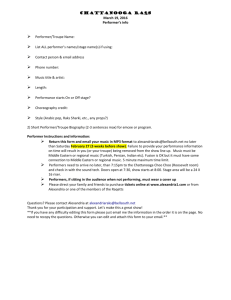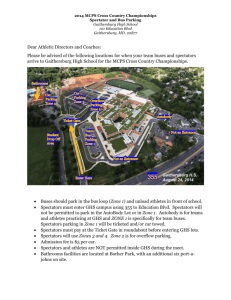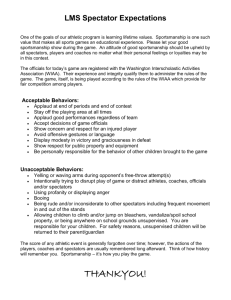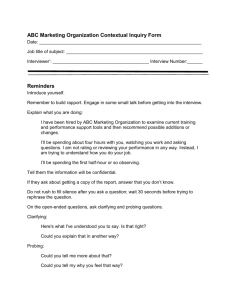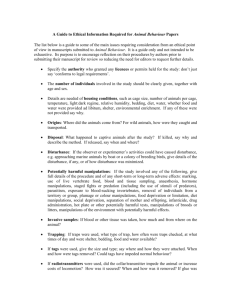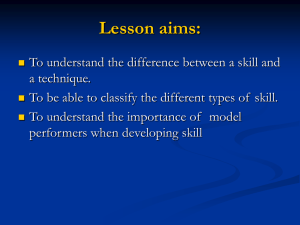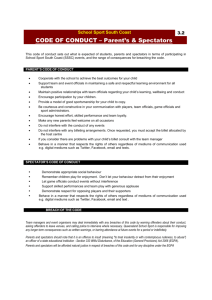summary: designing public interfaces
advertisement
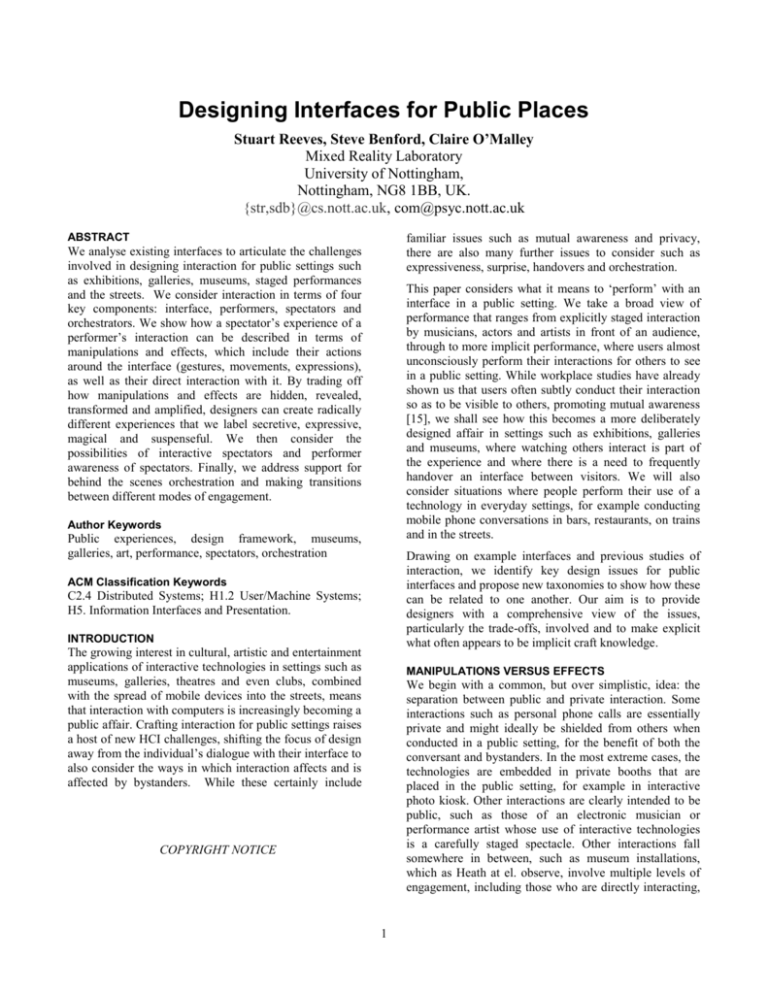
Designing Interfaces for Public Places
Stuart Reeves, Steve Benford, Claire O’Malley
Mixed Reality Laboratory
University of Nottingham,
Nottingham, NG8 1BB, UK.
{str,sdb}@cs.nott.ac.uk, com@psyc.nott.ac.uk
ABSTRACT
familiar issues such as mutual awareness and privacy,
there are also many further issues to consider such as
expressiveness, surprise, handovers and orchestration.
We analyse existing interfaces to articulate the challenges
involved in designing interaction for public settings such
as exhibitions, galleries, museums, staged performances
and the streets. We consider interaction in terms of four
key components: interface, performers, spectators and
orchestrators. We show how a spectator’s experience of a
performer’s interaction can be described in terms of
manipulations and effects, which include their actions
around the interface (gestures, movements, expressions),
as well as their direct interaction with it. By trading off
how manipulations and effects are hidden, revealed,
transformed and amplified, designers can create radically
different experiences that we label secretive, expressive,
magical and suspenseful. We then consider the
possibilities of interactive spectators and performer
awareness of spectators. Finally, we address support for
behind the scenes orchestration and making transitions
between different modes of engagement.
This paper considers what it means to ‘perform’ with an
interface in a public setting. We take a broad view of
performance that ranges from explicitly staged interaction
by musicians, actors and artists in front of an audience,
through to more implicit performance, where users almost
unconsciously perform their interactions for others to see
in a public setting. While workplace studies have already
shown us that users often subtly conduct their interaction
so as to be visible to others, promoting mutual awareness
[15], we shall see how this becomes a more deliberately
designed affair in settings such as exhibitions, galleries
and museums, where watching others interact is part of
the experience and where there is a need to frequently
handover an interface between visitors. We will also
consider situations where people perform their use of a
technology in everyday settings, for example conducting
mobile phone conversations in bars, restaurants, on trains
and in the streets.
Author Keywords
Public experiences, design framework, museums,
galleries, art, performance, spectators, orchestration
Drawing on example interfaces and previous studies of
interaction, we identify key design issues for public
interfaces and propose new taxonomies to show how these
can be related to one another. Our aim is to provide
designers with a comprehensive view of the issues,
particularly the trade-offs, involved and to make explicit
what often appears to be implicit craft knowledge.
ACM Classification Keywords
C2.4 Distributed Systems; H1.2 User/Machine Systems;
H5. Information Interfaces and Presentation.
INTRODUCTION
The growing interest in cultural, artistic and entertainment
applications of interactive technologies in settings such as
museums, galleries, theatres and even clubs, combined
with the spread of mobile devices into the streets, means
that interaction with computers is increasingly becoming a
public affair. Crafting interaction for public settings raises
a host of new HCI challenges, shifting the focus of design
away from the individual’s dialogue with their interface to
also consider the ways in which interaction affects and is
affected by bystanders. While these certainly include
MANIPULATIONS VERSUS EFFECTS
We begin with a common, but over simplistic, idea: the
separation between public and private interaction. Some
interactions such as personal phone calls are essentially
private and might ideally be shielded from others when
conducted in a public setting, for the benefit of both the
conversant and bystanders. In the most extreme cases, the
technologies are embedded in private booths that are
placed in the public setting, for example in interactive
photo kiosk. Other interactions are clearly intended to be
public, such as those of an electronic musician or
performance artist whose use of interactive technologies
is a carefully staged spectacle. Other interactions fall
somewhere in between, such as museum installations,
which as Heath at el. observe, involve multiple levels of
engagement, including those who are directly interacting,
COPYRIGHT NOTICE
1
those in an immediate co-located group who share the
interaction, and bystanders who observe from a distance,
learning by watching others and waiting their turn [23].
technology in order to rest of reposition themselves before
resuming a performance.
Finally, on this issue, interactive technologies may often
be used to enhance more traditional forms of
performance, for example sensing and responding to the
movements of dancers on a stage. In this case, performers
will continue dancing as they interact with the technology
and furthermore, spectators primary interest will continue
be in the movements and gestures of dance.
We argue, however, that this basic distinction between
public and private is not sufficiently rich to capture some
of the important design features of existing public
interfaces. In particular, it is important to consider exactly
what aspects of an interaction are revealed to bystanders
and in what way. We therefore introduce a further
distinction in order to help us express the various
possibilities; we consider interaction in terms of
manipulations and effects.
Effects
Effects are the results of these manipulations, for example
the display of images, graphics and sounds or the
actuation of physical objects.
Effects include the
‘content’ of the performance, but may also include other
visible effects of the performer’s manipulations of the
system, for example the appearance of menus, icons,
cursors and so forth that are necessary part of
manipulating the contents.
Manipulations
Manipulations are the actions carried out by the primary
user of the interface who we shall henceforth refer to as
the ‘performer’. They include manipulations of physical
controls (buttons, mice, joysticks and so forth) as well as
gestures, movements and speech that are otherwise sensed
by the interface.
Effects also include the apparent action of the interface on
the performer. These may be direct effects such as when
the performer is tethered to the interface, for example is
riding a motion platform that enables the interface to
move them about, or in a more extreme case may involve
the system actively controlling the performer’s body as
can be seen in the work of the performance artist Stelarc
in which the system causes his body to move through a
series of electrical impulses, triggered in the first instance
by spectators [22]. Performers also display a reaction to
the interface, deliberately or involuntary, so that some
gestures, movements and expressions around the interface
might be seen as being part of effects.
Manipulations also include actions that take place around
the interface but that do not directly result in input to it.
For example, performers may assume a particular
orientation so as to make themselves more or less visible
to others in the environment, henceforth referred to as
‘spectators’. Performers also often gesture around the
direct use of the interface, performing distinctive
movements prior to, or following on from, the actual
moment of interaction. This can be seen in traditional
performance contexts such as musicians playing
conventional instruments or sportspeople striking balls.
Such gestures play two important roles. First, interactions
are not only about the moment of contact; preparation and
follow through are essential components of a skilfully
performed physical action, perhaps best illustrated by a
golfers swing. Second, such gestures are an essential
aspect of deliberately performing interactions for others to
see and appreciate, expressing skill and control and
introducing an aesthetic component to the use of
technology. Rosen [16], for example, describes how
performer gestures at the piano fundamentally influence
spectator appreciation of the skill and emotion involved in
the performance of a piece of music. Previous work in
HCI has discussed the similar role of such performative
gestures in playing electronic instruments [7].
As a final note, manipulations and effects are not the same
as input and output, the key difference being that they
include surrounding actions that are not directly sensed or
driven by the interface, but that are an important part of
describing how someone performs with it in public.
DESIGNING THE SPECTATOR’S VIEW BY REVEALING
OR HIDING MANIPULATIONS AND EFFECTS
We are now ready to revisit and expand on basic ideas of
public and private, further developing them in terms of the
varied ways in which a spectator can perceive a
performer’s interaction. We can classify a wide range of
existing interfaces according the extent to which they hide
or reveal a performer’s manipulations compared to the
extent to which they hide or reveal the corresponding
effects. Figure 1 shows the resulting taxonomy, populated
with a range of example interfaces.
It is also important to consider the ways in which
performers engage with and disengage from interactive
technologies. The movements and gestures involved in
approaching the technology, for example in moving into
sensor range or putting on a wearable interface such as a
head-mounted display, are also part of performing
although they may not directly result in input to the
system. Similarly, performers may disengage from
At the bottom-left we see what is traditionally considered
to be private interaction in which both manipulations and
their effects are hidden from the spectator, an example
being any interface that located in a private booth such as
the photo kiosk example mentioned previously. Top-right
2
Figure 1: Classifying interfaces according to how they hide or reveal manipulations and effects
we see the most public interactions in which both effects
and the manipulations that cause them are revealed to
spectators. An interactive whiteboard belongs in this
general area, as do many conventional examples of single
display groupware in which people collaborate openly
around a shared display [24
Mobile personal displays
Due to their small size, many of the fine details of
interaction with mobile personal displays such as PDAs
and phones may be hidden from most spectators.
However, there are some subtle distinctions here. A
spectator is who close by, for example looking over the
shoulder of someone who is using a PDA, may be able to
observe their manipulations and the resulting effects.
More distant spectators will miss small manipulations
such as key presses, but will still be able to see that the
device is being used due to characteristic “phone
gestures” [11]. Mobile phones in particular project some
of their manipulations and effects into the surrounding
environment, including ring-tones and the performer’s
talk, which sometimes appears to be at least in part
deliberately performed for spectators in the local
environment as well as for the distant conversant. The
Finally, Sotto Voce museum guide system [1] is
especially interesting because a spectator can elect to
eavesdrop on a fellow participant’s audio (participants
were arranged into pairs, and proximity did not affect the
overhearing of this audio content). The choice over
whether to reveal or hide a co-visitor’s guidebook
manipulations was, in this example, controlled by a
secondary performer.
Re].
The areas to the top-left and bottom-right are somewhat
less conventional. Top-left are interfaces in which effects
are revealed but manipulations, including the performer
themselves in extreme cases, are hidden. Here we find
‘wizard of oz’ interfaces, for example a performer
speaking through a real-time animated character from offstage. Wizard of oz techniques are also sometimes used in
the early prototyping stages of interface design.
Bottom-right we have the converse, manipulations are
revealed but effects are hidden. Here spectators can watch
a performer using a display but cannot share in the content
of their experience. Examples include immersive headmounted displays when used publicly in exhibitions and
theme-parks and also peep-hole displays, for example the
Telescope, stand-mounted augmented reality display that
was deployed in a visiting experience; performers rotated
a large display and then looked through a small eye-piece
to see an augmented view of a physical target [25].
Interactive installations
Next, we consider other examples of public interfaces that
involve more subtle trade-offs between hiding and
revealing manipulations and effects.
Interactive installations demonstrate a variety of
approaches to hiding and revealing manipulations and
3
‘parasite’ human controller who was located in the same
space. The manipulations designed to be hidden from all
concerned retaining their anonymity, whereas their effects
were made visible on the cyborg’s body and so became a
talking point – for spectators.
effects. Some interfaces rely on spectator comprehension
of manipulations and their mapping to a revealed effect
for their entertainment value. Dance Dance Revolution
arcade machines, for example, present players with a set
of footpads (usually with eight ‘buttons’) that must be
triggered in specific sequences in time with an
accompanying soundtrack. Much of the entertainment is
that players are on public display, standing on a podium in
front of a screen so that both manipulations and effects are
revealed to spectators.
As a final example, we briefly draw attention to a quite
different and more everyday kind of performance, that of
giving presentations using tools such as Microsoft
Powerpoint. While such tools clearly provide powerful
and indeed popular facilities for creating and displaying
audio-visual material to support a spoken presentation, we
suggest that they suffer from some limitations in terms
their ability to support fluid performance, and that these
can be explained in terms of our taxonomy. Conventional
presentation packages display all of the activity on the
desktop including cursors, menus, buttons, system alerts
and often the contents of the desktop as the performer
begins or ends a presentation or switches applications
midstream. While we accept that both performers and
spectators may have become accustomed to seeing such
information, we feel that there is something inherently
clumsy in performance terms about publicly revealing all
of the background manipulations of the underlying
interface as well as the intended effects (i.e., the crafted
presentation material). As presenters, we have often
wanted to be able to secretly alter later slides as a
presentation progresses, perhaps in response to time
pressure or questions from the audience, without this
being visible to all. Maybe current mainstream
presentation packages should be redesigned to support a
clearer separation of manipulations and effects?
Projected 3D displays such as CAVEs reveal both
manipulations and effects to co-present spectators.
However, only a single tracked performer receives the full
3D experience that is correct for their physical
perspective, giving spectators a downgraded experience.
With the ToneTable [5], an interactive table-top display
that was exhibited in a science exploratorium, four
performers at a time used trackballs to interact with a
simulated physical model. There was a non-linear
mapping between performers’ manipulations and revealed
effects, so that while it was clear that performers were
interacting, the nature of cause and effect was not
immediately obvious, requiring further reflection.
We have already high-lighted the Telescope as an
example of an installation that reveals manipulations
while hiding effects. Related to this is the Augurscope, a
stand-mounted mobile display for viewing 3D models
from different physical vantage points when outdoors
[26], which displays effects on a laptop-sized screen, so
that spectators grouped around the display can see effects,
while those further away cannot not.
SECRETIVE, EXPRESSIVE, MAGICAL, SUSPENSEFUL
We now revisit our taxonomy in order to draw out some
design principles from the varied examples that we have
described. We propose that there are four general
approaches to designing public interfaces, each of which
addresses different concerns.
Performances
Artists who interact with technologies in front of
audiences are not always content with revealing
manipulations, but make actively seek to amplify them
into to make their performances more expressive.
Musician Pamela Z [21] uses gesture controllers in her
performances in order to control electronic instruments in
tandem with her voice. By using more expressive sensing
interfaces, she both reveals and then amplifies the
manipulations that are normally involved in the playing of
electronic instruments. As a different example, Toshio
Iwai’s pianos [20] are enhanced with automated lighting
effects that amplify his manipulations of a conventional
piano keyboard . Some of Stelarc’s performance pieces,
such as Stimbo [20], where muscle stimulators were
attached to Stelarc’s body and accessible via a touchscreen, see him assuming the role of the interface. In this
case, effects rather than manipulations are amplified.
Secretive interfaces tend towards hiding both
manipulations and effects. They respond primarily to the
desire to maintain a performer’s privacy and to minimise
annoyance for spectators.
Expressive interfaces tend towards revealing, even
amplifying, both manipulations and effects. For
performances, their primary concern is to entertain
spectators by enabling them to appreciate how the well a
performer is interacting with the system, for example
admiring the skill of a virtuoso user or being entertained
by a new user’s attempts to use the interface. For
installations, expressive interfaces are concerned with
attracting spectators and then enabling them to learn by
watching so that they can prepare themselves for their
own turn with the interface.
However, not all performance intefaces involve
amplification. In the Schizophrenic Cyborg [18], a
performer ‘cyborg’ had a digital display fixed onto their
torso, the content of which was manipulated by a
4
Magical interfaces tend towards revealing effects while
hiding the manipulations that led to them. Lamont and
Wiseman [13] discuss the fundamental base of magic as
relying on “methods” which lead to “effects.” A magician
may use many different methods to achieve the same
effect, however the magician’s skill lies in ensuring the
spectator is only aware of the effect. An important design
decision for magical interfaces is whether to reveal the
performer, making clear that they are causing the effects
while not giving away exactly how, or to hide the
performer altogether, in order to impress spectators with
the implied capabilities of the interface alone.
(e.g., PDAs, mobile phones and the Augurscope) or
perhaps through more explicit means (e.g., we could
redesign presentation tools so that background user
interactions were prevented from being projected along
with the primary content).
Transforming: we may transform manipulations, for
example by using non-linear algorithms or by aggregating
multiple inputs when mapping them onto effects. Such
techniques are used by artists to introduce an element of
unpredictability or ambiguity to an interface in order to
provoke curiosity and reflection (a more detailed
discussion of potential benefits of ambiguity for interface
design can be found in [27]). Alternatively, manipulations
may be transformed into unrelated actions by a performer
in order to mislead spectators, such as a magician’s
intentionally misleading bodily conduct that hides the
methods employed to produce a trick [13].
Suspenseful interfaces tend towards revealing
manipulations while hiding effects. While at first sight
this may appear to be the most surprising of the four
strategies, it does offer some interesting possibilities. As
with expressive interfaces, spectators may be attracted by
seeing the interaction and may be able to learn something
of what to do by observing, but will not experience the
effects until it is their turn. Watching others manipulate
and react to the interface may serve to build suspense,
heightening the ‘payoff’ delivered when it is finally their
turn. This is particularly appropriate in situations where
visitors have to pay for each individual experience, for
example interactive rides in theme-parks, in which case
only those who pay experience the actual content, while
people who are in line waiting their turn experience a
heightening of suspense.
Amplifying: performers may deliberately amplify their
manipulations and effects rather than merely reveal them.
Again, this may be as a result of physical scale
(manipulations of a large device are inherently more
visible) or through technical augmentations such as using
expressive sensing based interfaces or introducing
additional visualisations or sonifications of their
movements alongside the primary effects. For example,
Ed Tannenbaum’s video installation Recollections [20]
tracks the performer’s body movements and projects these
as silhouettes on a public display, layered to produce a
vibrant collage of the their movements over time.
Figure 2 positions these approaches on our taxonomy. It
also extends its axes to show more possibilities than
simply revealing or hiding manipulations and/or effects.
FURTHER ISSUES FOR SPECTATORS
So far, we have considered how a spectator perceives a
performer’s interaction with an interface, a combination
of how they perceive the interface and also how they
perceive the performer. However, designers also need to
attend to other important relationships within this
performer-interface-spectator triangle, including how does
the performer perceive the spectators, and how does the
interface perceive the spectators, or more simply, can the
spectators interact with the interface rather than just
passively observing it?
Performer awareness of spectators
Public performance, be it explicit or implicit, is
fundamentally about the relationship between performers
and spectators. The performer’s awareness of the
presence, activities and reactions of spectators is clearly
an important aspect of this relationship and will shape the
way in which they conduct their interaction in public.
Figure 2: comparing secretive, expressive, magical and
suspenseful approaches to designing public interfaces
In a typical staged performance, theatrical or musical, a
performer needs to be highly aware of audience presence
and reaction. In many situations, a performer will
communicate with an audience and will respond to
feedback such as cheering and applause. Even where
Our example interfaces demonstrate a wide range of
approaches to this issue including:
Partially revealing: effects and manipulations may be
partially revealed, either as a result of scale and distance
5
audiences are more restrained, the manifest presence of an
audience is clearly critical to the sense of ‘liveness’.
they could not see spectators, but where the spectators
saw a shadow projection of them using an HMD (an
example of partially revealing manipulations) [29].
Recent mobile performances that are played out on the
city streets have introduced a quite different twist to the
performer’s awareness of spectators. For example, Uncle
Roy All Around You is a game-like performance in which
members of the public, equipped with wireless PDAs,
search the city streets for a mysterious character, guided
by remote online players and also sometimes
encountering live actors and even interacting with
members of the public (e.g., asking strangers for help) as
they go [28]. The experience is carefully designed to give
street players (the performers in the sense of this paper)
the unnerving but exciting sense of being involved in a
conspiracy that potentially implicates everyone around
them, even casual bystanders. The key here is a
performer’s experience of interaction in public space is
greatly enhanced by an implied awareness and
involvement of spectators, even though this is often not
the case. As one player reported after the experience:
Interactive spectators
Another important possibility to consider is whether
spectators can themselves interact with the display, albeit
as a secondary form of interaction. Once again, this might
be desirable or problematic depending upon the situation.
There are two main ways in which spectator interactions
can be a problem. The first is interference, especially
accidental interference with sensing-based interfaces. This
is perhaps most obviously a problem with video-tracking
systems where spectators can unintentionally interfere by
moving into camera view, casting shadows or causing
changes in ambient lighting (e.g., blocking light sources,
opening or closing doors and blinds, or switching lights
on and off). The second potential problem concerns
safety. It is important to keep spectators at a safe-distance
from heavy and fast moving equipment, an issue for
almost any kind of theme-park experience. Both of these
problems can be overcome through appropriate ‘set
design’, i.e., the use of barriers, partitions, viewing
platforms and so forth, although sensor interference might
also be dealt with through careful sensor placement or
redesign of sensing software to filter out interference.
“My initial feelings were of slight paranoia because you
knew you were probably being watched and certainly
monitored. I felt very much on my own with no one to
confer with or discuss how to do it, or if it was the right way.
This was accentuated by the thought that people may be
watching you ‘doing it wrong’. I couldn’t help but look
around me to see whom else might be in on it”
It may also be desirable to enable spectators to interact,
for example providing direct audience feedback or more
subtly shaping an experience according to their collective
attention. Given that there will often be many spectators
involved, possibly thousands in a large audience, this
raises the issue of how to aggregate many individual
inputs into a meaningful interaction. Perhaps the most
familiar example is the use of voting systems by
television audiences, typically involving the use of a
remote-control device. Video-tracking of large audiences
offers further possibilities, with the most famous example
being Cinematrix [ref] in which individuals in a large
audience waved red or green paddles in order to play a
collecting game of Pong that was projected onto a large
screen. Other systems are able to track audience gestures
without objects [14]. A more general discussion of
aggregation techniques is beyond the scope of this paper.
However, before closing, we note that designers need to
consider the following key issues:
A more conventional awareness of spectators can be
found in museums, exhibitions and galleries. Studies of
interaction in such settings have identified different levels
of engagement, including directly interacting with an
exhibit, being part of a local co-visiting group gathered
around it, and being a bystander [14]. One implication is
that designers may need to engineer different kinds of
performer awareness of co-visitors as compared to
bystanders. Having sufficient awareness of co-visitors is
clearly important to a successful shared experience.
Highly personal interfaces such as audio-guides with
headphones can be problematic in this regard, motivating
approaches such as Sotto Voce described above [1].
Awareness of bystanders may be a different issue
however. An important factor here will be the pressure
felt by the performer, both in terms of the embarrassment
of potentially appearing stupid in front of strangers, as
well as he pressure to move on and let others have a turn.
Whether such pressure is a positive or negative factor
depends upon the situation, for example balancing the
performer’s enjoyment of the experience against the
pressure to maintain a high visitor flow.
We do stress however, that it is not always desirable for a
performer to be aware of spectators. Some contemplative
artistic experiences deliberately isolate the performer, an
interesting case being the virtual reality artwork Ozmose
where the performer was placed behind a screen so that
6
To what extent does each individual feel that they are
making a legitimate input? In this regard, MaynesAminzade et al advise that “what matters is what the
audience thinks is going on, not what is really going
on.” [14]
Do spectators directly see the combined effect? This
is likely to be the case for direct audience feedback,
although the social aspects of voting will be different
depending on whether the emerging result is seen
during voting or announced afterwards. For artistic
applications, collective spectator interaction may be
less obviously mapped onto a final effect.
A study of a second, this time mobile and distributed,
performance called Can You See Me Now? in online
players were chased through a virtual model of a city by
actors running through the actual city streets, similarly
highlighted the importance of orchestration, showing how
technical crew and actors worked together to monitor the
operation of the technology and resolve problems [31].
To what extent are spectators aware of each others’
input? The use of physical artefacts such as the
Cinematrix paddles makes this more visible,
encouraging social interaction among an audience.
Although we have focused on staged performances, we
note that orchestration occurs in many public settings.
Exhibitions in museums and galleries for example,
employ docents to manage visitor flow and explain
concepts and technologies, and of course have resources
for fixing displays that are ‘temporarily unavailable’.
ORCHESTRATION
Up to this point, we have discussed public interaction
solely in terms of in terms of performer, interface and
spectator, although we have already begun to see that this
simple categorisation is not rich enough to express all of
the design issues involved, for example in dealing with
the distinction between co-visiting spectators and more
general bystanders. We now introduce a fourth major
component – orchestrators.
These studies highlight the importance of orchestration
and identify a series of common concerns including:
introducing participants to an experience; managing their
exit; handling transitions between different phases of a
performance when engagement may easily be broken;
managing technical problems; and finally, maintaining the
pace of an experience so that it reaches a climax at an
appropriate time. In order to deal with these issues crew
and actors need to closely but invisibly monitor players
physically and virtually, manipulate them, and
communicate with one another.
Conventional staged performances usually involve an
element of orchestration, a set of activities that are
concerned with ensuring the smooth running of the
experience. In a conventional performance, these typically
include the activities of ‘front of house’ staff such as
ushers, receptionists, and announcers, as well as those
‘behind the scenes’, such as stage managers, floor
managers, prompters and an extensive technical crew
(sound, lighting, stagehands and so forth).
In terms of manipulations and effects, orchestrators will
ideally be aware of the manipulations and effects of other
participants, both performers and spectators, while having
their own manipulations hidden (and effects disguised)
from spectators and possibly also from performers where
these are members of the public.
Brenda Laurel has argued that interactive experiences can
also be thought of in terms of orchestration [30]. Studies
of interactive performances show that they too rely on a
significant element of orchestration, although the roles,
processes and technologies involved differ. Desert Rain
was a touring performance in which six ‘players’ at a time
carried out a time-limited mission in a mixture of a shared
virtual world and a physical stage set. At the heart of
Desert Rain, was a technology called the ‘rain curtain’, a
projection screen made of a fine water spray that could
hold a back projected image of the virtual world and
through which the players as well as actors could pass. An
ethnographic study of Desert Rain revealed the subtle
ways in which actors and technical crew orchestrated the
experience, introducing players, assisting players who
were struggling, hindering players who were doing too
well, and dealing with technical problems [33]. Ideally,
much orchestration was invisible to the players, for
example subtly repositioning their avatars via a remote
console. At other times, actors would make carefully
timed and delivered interventions, either over an audio
channel or face-to-face. In both cases, orchestrators would
invisibly monitor players’ activities from behind the
scenes, via secondary displays of their avatars’
viewpoints, or though the asymmetric rain curtain (it
appeared transparent from the far side, allowing
surreptitious monitoring of players)
TRANSITIONS
Our final issue for consideration? is that of dynamic
transitions between different modes of engagement. Many
experiences involve moments of transition, for example
interacting with museum exhibits may involve quite fluid
transitions between being a spectator and performer, or
between performers within a co-visiting group as they
hand control of the interface to one another. Designers
need to consider how frequent and fluid such transitions
will be and chose their technologies accordingly. For
example, handing over a wearable technology such as an
HMDs will be more difficult than walking up to and away
from a stand-mounted display. Designers also need to
consider the traditional issue of admission; how do people
enter the experience in the first place: at timed intervals or
whenever they like: as a stream of individuals or in
groups: and of course, do they require tickets?
The concept of ‘traversable interfaces’ accommodates
transitions between spectating and performing by
enclosing a performer and interface within a secondary
projected display (e.g., placing them behind a large
screen) while leaving spectators outside [34]. This fulfils
several purposes. First it isolates the performer and the
7
interactive technologies from interference by the
spectators. Second, it allows for a spectator view of events
to be generated separately which may not show all of the
performer’s effects, maintaining an element of surprise.
Third, by designing the screen so that spectators can
physically pass through it, it supports dynamic transitions
between spectating and performing. An example is the
Storytent, a two sided screen shaped like an A-frame tent
[32]. Spectators see only the public of the tent, but than
can then step inside and sit down to interact at which
point they also get to see the private side.
interface itself (I), including both its physical and
software manifestations; performers, the primary users of
the interface (P); spectators, others in the public setting
who observe the performers’ interactions (S); and
orchestrators, those who steer the interaction, often from
behind the scenes (O). The designer needs to consider to
what extent each of these is present and also whether it
makes sense to further divide them into sub-categories,
for example, distinguishing between co-visiting spectators
and more general bystanders in a museum exhibit, or
distinguishing between control-room and mobile staff in a
mobile performance.
Another example of a public experience that relies on
rapid transitions is Deus Oculi [12], a large renaissancestyle painted scene featuring two figures whose faces
were painted on small doors. When a visitor, assuming the
role of a performer, opened a door and peered inside, an
image of their face was captured on a hidden video
camera and then displayed on a separate screen nearby.
As a result, performers could not see the effects of their
own manipulations, where as spectators could, resulting in
highly engaging collaborative exchanges as they pointed
them out to the performers and/or other spectators.
S
I
P
O
Figure 3: Interface, Performer, Spectator, Orchestrator
As an aside, there is a broader and longer term sense in
which some interactive installations and performances are
encouraging transitions, by turning previously ‘passive’
spectators into now ‘interactive’ performers. As a
consequence, the traditional role of actors may also be in
transition, from being performers to being orchestrators,
shaping and embellishing public performance rather than
being the primary focus of attention or in some more
extreme cases to being the interface itself.
Next, it is important to consider the possible relationships
between these components. In what ways should each of
performers, spectators and orchestrators be able to interact
with the interface and how should such interactions be
perceived by the others? A useful approach to these
questions is to consider interactions in terms of
manipulations, including direct interaction and as well as
performative action around the interface; and effects,
including displayed output as well as human reactions.
SUMMARY: DESIGNING PUBLIC INTERFACES
The first lesson from this paper is that designing
interfaces for public places is a complex task, raising
significant new challenges for interaction design. We also
see that experience designers are already able exploit
extensive craft knowledge when creating public
installations and performances, drawing on a wide range
of existing examples that embody innovative approaches
to public interaction. We suggest that as computers
continue to spread from the workplace, where they
originated, into public life, so mainstream interface
designers will increasingly need to deal with these same
issues. In short, designing engaging, expressive and
appropriate interaction with computers in public places
will become a core part of interaction design, just as
usability is today.
Designing the spectator experience
Perhaps the central issue for spectators is how they
perceive performers’ interactions. We have identified four
design strategies which differ according to whether they
seek to hide or reveal manipulations and/or effects:
Secretive interfaces tend towards hiding both, minimising
annoying distractions when personal technologies are
used in public settings, or maintaining complete surprise
until it is their turn to perform.
Expressive interfaces tend towards revealing both,
enabling spectators to appreciate performers’ skill in
using an interface and their emotional engagement with it.
Magical interfaces tend towards revealing effects while
hiding the manipulations that caused them, encouraging
spectators to believe that either the interface or the
performer has some capabilities that they in fact do not.
We have therefore reviewed and compared a variety of
existing examples in an attempt to distil key issues and
approaches and articulate some general design principles,
which we now briefly summarise.
Suspenseful interfaces tend to reveal manipulations while
hiding effects, engaging spectators attention, building
anticipation and enabling them to prepare for interaction
A good starting point is to consider four general
components of a public interface as shown in figure 3: the
8
by watching others, while preserving the ‘payoff’ of the
content until it is their turn to perform.
orchestration may be revealed to performers (who are in
on the act) while remaining hidden from spectators.
However, designers have more options than simply hiding
or revealing; they can in fact partially-reveal, transform,
aggregate and also amplify manipulations and effects,
leading to a wide range of different interfaces as we have
evidenced by just the small selection that we reviewed.
The final issue to be considered by experience designers
is that of transitions; how do people move into and out of
these different modes of participation? In particular, how
do they enter an experience in the first place and then how
do they subsequently move from being a spectator to a
performer and back again. Specialised technologies such
as traversable interfaces may have a role to play here.
A final issue for the spectator experience is whether
spectators can interact, even if they are not the primary
users of an interface. Designers may need to prevent this,
perhaps for safety reasons or to prevent them interfering
with sensing technologies such as video-tracking.
Alternatively, they may wish to encourage it, enabling
spectators to provide feedback during an experience,
drawing on mass interaction techniques if a large audience
is present.
While we hope that this paper has helped gather together
some of the key design issues for public interfaces, we
finish by noting some issues that it has not addressed.
First is a greater specialisation of modes of engagement.
We have already seen that there may be different kinds of
spectators and the same may be true of both performers
and orchestrators who may assume specialised roles
within an experience. Second is a consideration of
distributed experiences that connect multiple interfaces
and environments. For example, the familiar idea of
having a remote presentation to a live audience via a
video link raises complicated design issues in terms of
seeing manipulations and effects that are transmitted
between two different interfaces. Finally, is the idea of
designing an overall visiting experience in which
performers and spectators move between multiple
installations, raising further challenges in terms of
transitions and ways of linking different performances.
These issues provide topics for further work..
Designing the performer experience
The performer experience has been the traditional focus of
HCI and there is already a wealth of literature covering
usability, engagement, emotional response, interacting
with sensors and so forth. We do however, emphasise two
particular issues from this paper.
The first is deliberately designing space around the
interface where performers can act without making input
to the system, enabling them to make expressive gestures,
supporting preparation and follow through for precise
gestures, and generally enabling the technology to be
embedded within other activities such as dance and
acting. In turn, this requires that performers can easily
engage with and disengage from the technology.
ACKNOWLEDGEMENTS
We gratefully acknowledge the support of the
Engineering and Physical Sciences Research Council
(EPSRC)
through
the
Equator
project
(www.equator.ac.uk).
The second is to consider whether performers should be
aware of the presence of spectators or not. While such
awareness is a vital part of live performance, it may
potentially put performers under pressure when using
installations (although we have seen that the feeling of
being watched is a powerful aspect of some experiences).
REFERENCES
1. Aoki, P.M., Grinter, R.E., Hurst, A., Szymanski,
M.H., Thornton, J.D. and Woodruff, A. {Sotto Voce}:
exploring the interplay of conversation and mobile
audio spaces. in Proceedings of the SIGCHI
conference on Human factors in computing systems,
ACM Press, 2002, 431--438.
2. Bellotti, V., Back, M., Edwards, W.K., Grinter, R.E.,
Henderson, A. and Lopes, C. Making sense of sensing
systems: Five questions for designers and
researchers. in Proceedings of SIGCHI Conference on
Human Factors in Computing Systems (CHI), ACM
Press, 2002, 415--422.
3. Benford, S., Reynard, G., Greenhalgh, C., Snowdon,
D. and Bullock, A. A Poetry Performance in a
Collaborative Virtual Environment. IEEE Computer
Graphics and Applications, 20 (3). 66--75.
4. Benford, S., Rowland, D., Flintham, M., Hull, R.,
Jo~Reid, Jo~Morrison, Facer, K. and Clayton, B.
``Savannah'': Designing a Location-Based Game
Designing the orchestrator experience
Orchestration is an important issue for public experiences
and introduces further demands of the interface.
Orchestration covers a range of tasks including inducting
participants, managing their exit, handling transitions,
managing technical problems, and maintaining pace, all of
which involve three underlying activities: monitoring the
physical and virtual states of performers and spectators;
intervening is different ways, and communicating.
Very often, it will be important to hide orchestrators’
manipulations and even effects from the other
participants, requiring specialised interfaces that enable
them to observe and intervene without being noticed. For
staged performances however, some aspects of
9
Simulating Lion Behaviour. in Proceedings of
Conference on Advances in Computer Entertainment
(ACE), 2004.
5. Bowers, J. {TONETABLE}: A Multi-User, Mixed
Media, Interactive Installation. in Proceedings of
COST G-6 Conference on Digital Audio Effects
(DAFX-01), 2001.
6. Bowers, J. and Hellstr\&\#246;m, S.O. Simple
interfaces to complex sound in improvised music. in
Extended Abstracts on Human Factors in Computing
Systems (CHI), ACM Press, 2000, 125--126.
7. Cohen, H. The further exploits of {AARON}, painter.
Stanford Humanities Review, Constructions of the
Mind: Artificial Intelligence and the Humanities, 4
(2).
8. Drozd, A., Bowers, J., Benford, S., Greenhalgh, C. and
Fraser, M. Collaboratively Improvising Magic: An
Approach to Managing Participation in an On-Line
Drama. in Proceedings of European Conference on
Computer-Supported Cooperative Work (ECSCW),
Kluwer, 2001, 159--178.
9. Ferris, K., Bannon, L., Ciolfi, L., Gallagher, P., Hall,
T. and Lennon, M. Shaping experiences in the {Hunt
Museum}: A design case study. in Proceedings of
ACM Conference on Designing Interactive Systems,
ACM Press, 2004, 205--214.
10. Flintham, M., Benford, S., Anastasi, R., Hemmings,
T., Crabtree, A., Greenhalgh, C., Tandavanitj, N.,
Adams, M. and Ju~Row-Farr. Where on-line meets on
the streets: experiences with mobile mixed reality
games. in Proceedings of SIGCHI Conference on
Human Factors in Computing Systems (CHI), ACM
Press, 2003, 569--576.
11. Geser, H. Towards a Sociological Theory of the
Mobile Phone, University of Z{\"u}rich, 2001.
12. Heath, C. and Lehn, D.v. Misconstruing Interactivity.
in M.~Hinton ed. Interactive Learning in Museums of
Art and Design, Victoria and Albert Museum, 2003.
13. Lamont, P. and Wiseman, R. Magic in Theory: An
introduction to the theoretical and psychological
elements of conjouring. University of Hertfordshire
Press, 1999.
14. Maynes-Aminzade, D., Pausch, R. and Seitz, S.
Techniques for Interactive Audience Participation. in
Proceedings of IEEE International Conference on
Multimodal Interfaces (ICMI), 2002.
15. Rinaldo, K.E. and Grossman, M.S. The Flock. in
Proceedings of IEEE Computer Graphics Visual
(SIGGRAPH), ACM Press, 1993.
16. Rosen, C. Piano Notes: The Hidden World of the
Pianist. Penguin Press, 2002.
17. Sanneblad, J. and Holmquist, L.E. ``{Why is everyone
inside me?!}'' {Using} Shared Displays in Mobile
Computer Games. in Proceedings of International
Conference on Entertainment Computing (ICEC),
2004.
18. Sheridan, J., Dix, A., Lock, S. and Bayliss, A.
Understanding Interaction in Ubiquitous Guerrilla
Performances in Playful Arenas. in Proceedings of
British HCI Conference, 2004.
19. Sudnow, D. Ways of the Hand: The Organization of
Improvised Conduct. Routledge \& Kegan Paul Ltd,
1978.
20. Wilson, S. Information Arts: Intersections of art,
science and technology. The MIT Press, 2002.
21. Z, P. Audible Image/Visible Sound: {Donald
Swearingen's} {Living Off The List}. 21st Century
Music, 8 (1).
22 Ref to Stelarc's work
23 Ref to KCL paper about different levels of
engagement with museum exhibits
24 General ref to single display groupware?
25 Telescope
26 CHI 2002 Augurscope
27 CHI 2003 Ambiguity
28 Uncle Roy ACE 2004
29 Ozmose
30 Brenda Laurel
31 CYSMN CHI 2004
32 Storytent - ECSCW 03 or maybe CHI 2002 short
paper
33 Desert Rain - CHI 2001
34 Traversable interfaces - CHI 2000
10

